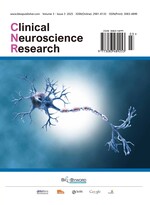Exogenous Compression Caused by a Mass at the Bifurcation of the Carotid Artery
Abstract
The bifurcation of the carotid artery is a crucial node for blood supply to the brain. External compression caused by surrounding masses can lead to severe hemodynamic disturbances and neurological abnormalities. This article reviews the pathogenesis, clinical manifestations, diagnostic methods, and treatment approaches of this condition, including the pathological characteristics of common compression lesions such as carotid body tumors and schwannomas. It compares the applicability of imaging examination methods such as ultrasound, CTA, and DSA, analyzes the suitable conditions and treatment effects of surgical removal, vascular reconstruction, and interventional therapy. The research aims to provide standardized diagnostic and treatment concepts for clinical practice, emphasizing the crucial role of individualized treatment plans in improving patient outcomes. It also looks forward to the development trend of precision medicine guided by imaging.
References
Shen LG, Li LB, Yang J, et al., 2007, Diagnostic and Therapeutic Analysis of 17 Cases of Carotid Body Tumors. 2007 Zhejiang Provincial Peripheral Vascular Surgery Annual Meeting.
Li X, Xin SJ, Zhang J, et al., 2010, Diagnosis and Treatment of Masses at the Carotid Artery Foreshore. Chinese Journal of General Surgery, 2010(12): 5.
Motomiya M, Karino T, 1984, Flow Patterns in the Human Carotid Artery Bifurcation. Stroke; A Journal of Cerebral Circulation, 15(1): 50.
Botnar R, Rappitsch G, Scheidegger MB, et al., 2000, Hemodynamics in the Carotid Artery Bifurcation. Journal of Biomechanics, 33(2): 137–144.
Ma P, Li X, Ku DN, et al., 1997, Convective Mass Transfer at the Carotid Bifurcation. Journal of Biomechanics, 30(6): 9–12.
Smith D, Larsen JL, 1979, On the Symmetry and Asymmetry of the Bifurcation of the Common Carotid Artery. Neuroradiology, 17(5): 245–247.
Koktzoglou I, Walker MT, Meyer JR, et al., 2016, Nonenhanced Hybridized Arterial Spin Labeled Magnetic Resonance Angiography of the Extracranial Carotid Arteries Using a Fast Low Angle Shot Readout at 3 Tesla. Journal of Cardiovascular Magnetic Resonance, 18(1): 12.
Ibrahim HA, Sepahdari AR, 2015, Enhancing Mass at the Carotid Bifurcation: Not Always a Carotid Body Tumor. Neurographics, 5(3): 88–95.
Piccirelli M, Dezanche N, Nordmeyer-Massner J, et al., 2008, Carotid Artery Imaging at 7T: SNR Improvements using Anatomically Tailored Surface Coils. Proceedings 16th Scientific Meeting, International Society for Magnetic Resonance in Medicine, 3–5.
Chen JJ, Chen DL, 2009, Carotid Artery Malformation Presenting as a Neck Mass. Taiwan Journal of Otolaryngology, 44(2): 56–58.
Wang G, Lu XR, 2010, Diagnosis and Imaging Features of Carotid Body Tumors Using 64-Slice MSCTA. Chinese Journal of Clinical Medical Imaging, 2010(5): 21.
Kobayashi N, Karino T, 2016, Flow Behavior and Distribution of Embolus-Model Particles at the Terminal Bifurcation of the Human Internal Carotid Artery. World Neurosurgery, 2016(90): 469–477.
Shigeru TADA, 2010, Effects of Variation in Carotid Bifurcation Anatomy on the Oxygen Transport at the Artery Wall (Fluids Engineering). Transactions of the Japan Society of Mechanical Engineers, 76(772): 2127–2134.
Ogunleye OA, Ijaduola TA, Adeosun AA, et al., 2006, Carotid Body Chemodectoma and Carotid Aneurysm—A Case Illustration of Diagnostic Problems. Nigerian Journal of Otorhinolaryngology, 2006(2): 7–9.
Weber F, 2009, The Progression of Carotid Intima-Media Thickness in Healthy Men. Cerebrovascular Diseases, 27(5): 472–478.

